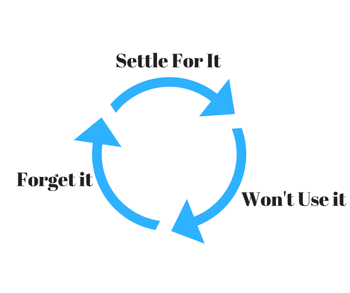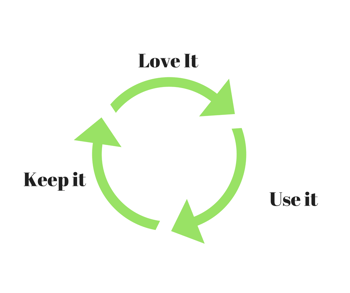Authentic, Highly Effective Emotional Selling In Five Steps

Subscribe to our newsletter
Updated November 13, 2024
Do you know where so many retail salespeople go wrong with emotional selling?
They try to sell based on the features they think are important. The trouble with that is shoppers are unique; they have their reasons for buying things.
They want to buy using their morals, values, and feelings.
Legendary speaker Tony Robbins tells a story about a woman in the audience who said she bought a $2,000 Louis Vuitton purse. When he asked why she bought it, she replied:
“Because it said something about me.”
That luxury purse made her feel successful instead of practical and frugal. As Robbins noted to the audience, she wasn’t buying a purse but an identity.
Another woman in the audience volunteered that she had purchased her purse for just $30, and she was “damn proud of that fact because she wanted to be seen as pragmatic, and that’s what that purse did for her.”
One person’s reasons to buy a purse or any object aren’t better or worse than another’s. It is how these customers want to see themselves and to be seen by others.
You’ve heard me say it plenty of times … people buy feelings, not things.
The old saw "you sell the sizzle, not the steak" is also a form of that.
Martin Lindstrom, in his book "Small Data: The Tiny Clues That Uncover Huge Trends," notes:
“We desire whatever it is - the place, the person, the thing, the period in our lives - we’re convinced we’re lacking.”
Here’s the thing:
If your product or service helps a dad be a hero when he fixes the dishwasher drain or helps a mom feel like a million dollars in a new outfit for the company party, or helps a customer see themselves in a new light as stronger, more fun-loving, or more studious -- then you’ve helped them bolster their identity.
What emotional selling looks like
When you work the fitting room and show that perfect dress …
Or when you build rapport for the guy to get the perfect engagement ring …
They will love it forever when you connect their heart to their purchase.
Sorry, omnichannel retailers -- I doubt many love their online purchases as much as a brick-and-mortar shopper.
Maybe that's why returns are so important to online shoppers. A ComScore study found that 60% of customers read a company's return policy, and 80% are influenced to buy or not based on what they find.
There’s no commitment.
No winning over.
No challenge to get better than you searched for.
Maybe that’s why apparel returns, in particular, run between 25 and 50%.
Maybe that’s why the buy-online-pickup-in-store (BOPIS) yields 30- 40% of non-pickups. There’s no commitment.
71% of buyers shop online to get a better deal.
They only bought it for the price ...
And I think a lot of customers settle for price.
 That’s not to say some consumers don’t love much of the stuff they buy online, but that’s because they’re in a willing-to-settle-for-it mood.
That’s not to say some consumers don’t love much of the stuff they buy online, but that’s because they’re in a willing-to-settle-for-it mood.
They got the coupon.
They downloaded the discount.
They feel smart.
More digital experiences are more diverting than truly rewarding.
Why do you think flash sales are so effective? The customer did not know whether it was a good deal or even if it would be something they would love. They got a low price and ordered without thinking.
 However, the real point of this blog is to help you help customers assume a higher level of satisfaction with their lives or new identities.
However, the real point of this blog is to help you help customers assume a higher level of satisfaction with their lives or new identities.
Carl Richards wrote about his aha moment when he realized he’d been buying cheap too much when it came to bikes:
“We all know what happens with the cheaper bike. It breaks! It wears out, you replace it. And not only does good gear last, but when you buy cheap stuff, you get bored with it. I do not get bored with this bike, and that is why it is saving me money.”
Carl wasn’t being frugal; he found a bike he could love without reservations. He got tired of settling. He concluded his article with this …
”Don’t just buy nice, buy what you love. If you don’t, you’ll end up hating, and replacing, until you do.”
Are your shoppers loving or just settling for your products?
Do your employees know how to help a customer flirt with a product and take it home? To love, honor, and cherish each other?
I doubt it because retailers have gotten into the settling business. It’s logical, practical, and can produce reams of features.
But as Tom Hopkins, one of my earliest sales mentors, says, “Logic in sales is a gun without a trigger. You can twirl it all you care to, but you can’t fire it. Emotion has a trigger.”
Emotional selling in five steps for happy customers who spend more money
In just five steps, you can build a genuine connection with your customers and help them get what they want from the shopping experience. When you discover the emotional state they are trying to achieve, selling the solution becomes easier.
1. Ask yourself, “What emotion will this product give this customer?”
Remember, it’s not about you.
2. Identify your customer’s desired emotion
Based on your initial conversation and rapport-building, go deeper than “What are they looking to buy?”
Ask yourself, “Which of these five emotions is the shopper looking to receive from this purchase?”
Will it confirm or give them:
- Status?
- Intelligence?
- Pleasure?
- Power?
- Individuality?
3. Paint a picture
Use that supercharged emotion in your storytelling about the product and paint a picture of how they’ll feel when they take it home.
4. Tell a story
Share at least one story of a past customer’s experience who gained confidence from taking home an Armani jacket and showing up at the boardroom the next day, displayed their individuality at Christmas dinner with local artist place settings, or was able to create a memory book on their computer with your product.
5. Close the sale
Finally, reinforce those emotions by mentioning them in your close. Tying those emotions into your follow-up personalized emails after they purchase is also important to help seed future sales.
Why emotional sales techniques are so effective
After a punishing election cycle, a prolonged pandemic, or a time of economic uncertainty, people doubt their beliefs and believe their doubts. When they show up in your store, they hope to attain at least one of these five emotional states -- if not more.
Be different than the merchant trying to get shoppers to settle based on price.
Any purchase can give someone some satisfaction.
But does satisfied earn raving fans?
No.
When you develop your retail sales training to include selling using emotions, your employees can feel like the shopper and figure out what emotion they are trying to acquire. Then, not only have you made the sale, but your customer loves their purchase.
They don’t question it when they get home.
They love it.
And no one questions why they bought it either.
They wonder where they got it.



